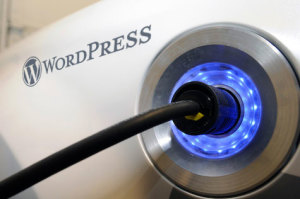So you’ve decided to build your own artist portfolio website! At this stage, you’ve chosen a fantastic web host, and now you’re ready to get your domain name and install WordPress.
Securing Your Domain Name
 A domain name is the unique combination of characters that lets the internet know where to find your stuff (e.g. http://google.com). If you don’t have a domain name already, you can usually buy one when you sign up for a hosting account. This will simplify things later, as you probably won’t have to do much, if anything, to point your domain name to your new website.
A domain name is the unique combination of characters that lets the internet know where to find your stuff (e.g. http://google.com). If you don’t have a domain name already, you can usually buy one when you sign up for a hosting account. This will simplify things later, as you probably won’t have to do much, if anything, to point your domain name to your new website.
If you already own a domain name, you’ll most likely need to log in to your domain registrar (the place where you pay for your domain name) and point your nameservers to your new web host. To find your new host’s nameservers, go to their support website and search for “[host name] nameservers” — 99% of the time, that will get you there.
Nameserver addresses will look like this: ns1.hostname.com, ns2.hostname.com, etc. There are usually two or three of them.
Next, log into your domain registrar and look for something that says “DNS” or “Edit your domain.” (Host support/documentation is your friend here.) Copy/paste your host’s nameservers into the appropriate boxes (e.g. Nameserver #1, Nameserver #2, etc.). Be sure your new host’s nameservers are all there, and that they’re the only nameservers your domain is using.
Once you’ve saved your new nameservers, sit back and have a cup of coffee or three — it could take up to 2 days for the changes to take effect, although it usually happens within 12 hours.
Installing WordPress
 This is going to be the shortest section of our tutorial, because the only real advice here is to check your host’s documentation on how to do it. If you followed our suggestion above and chose a host with a one-click install process, this should be pretty easy!
This is going to be the shortest section of our tutorial, because the only real advice here is to check your host’s documentation on how to do it. If you followed our suggestion above and chose a host with a one-click install process, this should be pretty easy!
Unless you know a lot about databases, when you run your one-click install, always check the option to let the installer create a database for you. Unless you have a *really* good reason, don’t change any of the default options.
Let the installer create the database for you.
And just like that, your setup is complete! Next time in Part 3, we’ll be getting you acquainted with the power and flexibility of the WordPress software.
Until then, feel free to send us your questions and thoughts about what you’d like to see discussed here at Artist Web School! #WordpressForArtists









